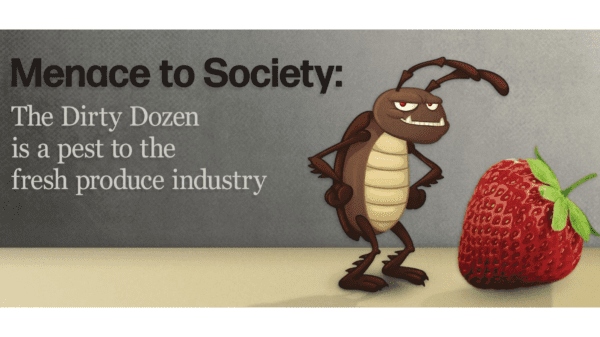The Dirty Dozen. The World War II action classic film from 1967 still holds up well.
Lee Marvin is assigned a group of twelve condemned criminals (played by actors such as Charles Bronson, Telly Savalas, and Donald Sutherland) to make a suicidal assault on a gathering of Nazi generals. In the unlikely event any of them survive, they will be granted full pardons.
Today the produce industry finds another Dirty Dozen as vexatious as the Wehrmacht brass found Marvin’s wayward crew.
Indeed, it has become a kind of ritual for the industry to inveigh against the latest release of each year’s twelve allegedly most contaminated produce items, issued by the advocacy nonprofit organization known as the Environmental Working Group, or EWG.
The list comes from the EWG’s “Shopper’s Guide to Pesticides in Produce,” which, according to the organization’s website, “ranks the pesticide contamination of 46 popular fruits and vegetables.”
The EWG claims the guide is based on test results by the U.S. Department of Agriculture (USDA) and U.S. Food and Drug Administration (FDA) “of more than 46,000 samples of produce. It is important to note that the samples are tested for pesticides after they have been prepared to be eaten.”
According to Alex Formuzis, senior vice president of communications and strategic campaigns for the EWG, the organization “published the first version of the Shopper’s Guide in 2004 to give consumers a tool they could use to reduce dietary exposures to toxic pesticides.”
Industry Counterclaims
Many produce industry spokespeople and nutritionists criticize the Dirty Dozen list—often vehemently.
Registered dietitian and podcaster Melissa Joy Dobbins argues the EWG uses “scare tactics to make conventional produce sound like it’s high in pesticide residues when, in fact, all produce regardless of organic or conventional production contains levels of pesticide residue that are far below the limits set by the EPA’s [U.S. Environmental Protection Agency’s] strict regulations. Research shows that the benefits of consuming fruits and vegetables far outweigh any minute exposure to pesticides.”
Carrie Dennett, nutrition columnist for the Seattle Times, says, “The Dirty Dozen conveys the false idea that ‘conventional’ produce is unsafe to eat, because even produce on that list has pesticide residues far below the upper limits allowed by the USDA.”
“I don’t believe the Dirty Dozen accurately reflects the benefits of consuming fresh fruits and vegetables,” comments nutritionist Elizabeth Shaw. “Whether organic or conventionally grown, fresh or frozen, canned or dried, we have a plethora of research that supports the benefits of consuming produce in all forms to improve health, diet, and chronic health conditions, such as cardiovascular disease.”
Teresa Thorne, executive director of the Alliance for Food and Farming (AFF), has this to say: “The so-called ‘dirty dozen’ list has been repeatedly discredited by the scientific community, and peer-reviewed science has shown its recommendation to substitute organic forms of produce for conventional forms has no impact on risk and is not scientifically supportable.”
Thorne points to a 2011 study by Carl K. Winter and Josh M. Katz published in the Journal of Toxicology entitled “Dietary Exposure to Pesticide Residues from Commodities Alleged to Contain the Highest Contamination Levels,” which investigates EWG claims.
The study concluded: “(1) exposures to the most commonly detected pesticides on the twelve commodities pose negligible risks to consumers, (2) substitution of organic forms of the twelve commodities for conventional forms does not result in any appreciable reduction of consumer risks, and (3) the methodology used by the environmental advocacy group [EWG] to rank commodities with respect to pesticide risks lacks scientific credibility.”
Formuzis points to studies that do show health effects: “In 2011, three separate studies found that babies exposed to organophosphate pesticides in the womb had lower IQ scores than their peers when they started school. The exposure routes in these studies were not specific to food, but the pesticides in question are widely used on conventional produce.”
Formuzis also cites another study, published in the 2018 JAMA Internal Medicine: “Higher consumption of high-pesticide residue FVs [fruits and vegetables] was associated with lower probabilities of pregnancy and live birth following infertility treatment with ART [assisted reproductive technologies].” Further, the data suggests, “dietary pesticide exposure within the range of typical human exposure may be associated with adverse reproductive consequences.”
This an excerpt from the cover story in the May/June 2022 issue of Produce Blueprints Magazine. Click here to read the whole issue.



